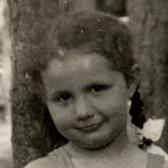
-
Learn More about Sylvia
- Collections View Sylvia's family photographs
- First Person Watch Sylvia share her Holocaust experiences at a First Person program
Sylvia Rozines was born Cywia Perelmuter on January 20, 1935, in Łódź, Poland. Her father, Isaac, was a salesman, and her mother, Haya, cared for Sylvia and her elder sister, Dora, who was eight years older.
World War II began when Germany invaded Poland on September 1, 1939. Within seven days, German troops entered and occupied Łódź. The Germans attacked and killed Jews, confiscated and looted Jewish-owned property, and enacted other antisemitic restrictions. They required Jews to wear a yellow Star of David badge on the front and back of their clothing.
In the spring of 1940, the Germans forced 160,000 Jews from Łódź, including Sylvia and her family, to move into a ghetto. The Łódź ghetto (also called Litzmannstadt ghetto) was surrounded by a barbed-wire fence that separated it from the rest of the city. Food was scarce, and diseases, like typhus, spread throughout the ghetto. Conditions became ever more overcrowded as Germans deported Jews from other places to the Łódź ghetto beginning in fall 1941.
Residents of the ghetto were required to work for the Germans. Isaac delivered flour while Haya and Dora worked in a clothing factory, one of seventy-four workshops in the ghetto. Initially, there had been schools in the ghetto, but as of fall 1941 Sylvia and all other Jewish children no longer were allowed to attend school.
In January 1942, deportations of Jews began from the Lodz ghetto to the Chełmno killing center. In September 1942, the so-called “Gehsperre” or “curfew” deportation action took place. The Germans searched for and rounded up the elderly, the sick, and children under the age of 10 . Sylvia was just 7 at the time. When the Germans began searching for children street by street, Isaac found hiding places for himself and Sylvia. The action lasted for days and Isaac often had to secure a new hiding place every day. On one occasion, they hid in a cemetery until Dora was able to tell them it was safe. After the roundup ended, things stabilized in the ghetto. Sylvia spent most of her time with two other Jewish girls who lived in her apartment building. Since most of their toys had been traded for supplies and food, they invented new games and played with dolls made from old sheets to occupy their time.
In summer 1944, the Germans began the final liquidation of the Łódź ghetto. In June-July 1944, they deported approximately 7,000 Jews to Chełmno killing center. Then in August 1944, they told the more than 65,000 remaining Jews to pack their belongings and report to the train station. They were deported to Auschwitz-Birkenau killing center. A small group of adults were selected to stay and clear out what remained behind in the ghetto. Isaac, Haya, and Dora were among them. Isaac was able to sneak nine-year-old Sylvia into a cellar when the guards were not watching. Eleven other children were hidden with Sylvia in the cellar while the adults lived in two factory buildings nearby. In the winter of 1944, German guards discovered the children in the cellar, dragged them outside, and allowed them to live with the adults.
On January 19, 1945, the day before Sylvia’s tenth birthday, some 877 Jews, including Isaac, Haya, Dora, and Sylvia, were liberated from the Łódź ghetto by the Soviet army. At first, the family remained in the city where Isaac reestablished his business and Sylvia and Dora attended school. Sylvia and Dora experienced antisemitism in school in postwar Poland. Fearing antisemitic violence, the Perelmuter family relocated to a displaced persons camp in Allied-occupied Germany in 1945. From there, they made their way to Paris, where Haya’s brother was living. Sylvia spent her teenage years in Paris until she immigrated to the United States in 1957.
Sylvia married David Rozines, a Holocaust survivor from Poland, in 1959, and they settled in Albany, New York. They had a son and two grandchildren. Sylvia worked in the New York school system for 24 years. Following David’s death, Sylvia relocated to the Washington, DC, area and volunteered at the United States Holocaust Memorial Museum.
